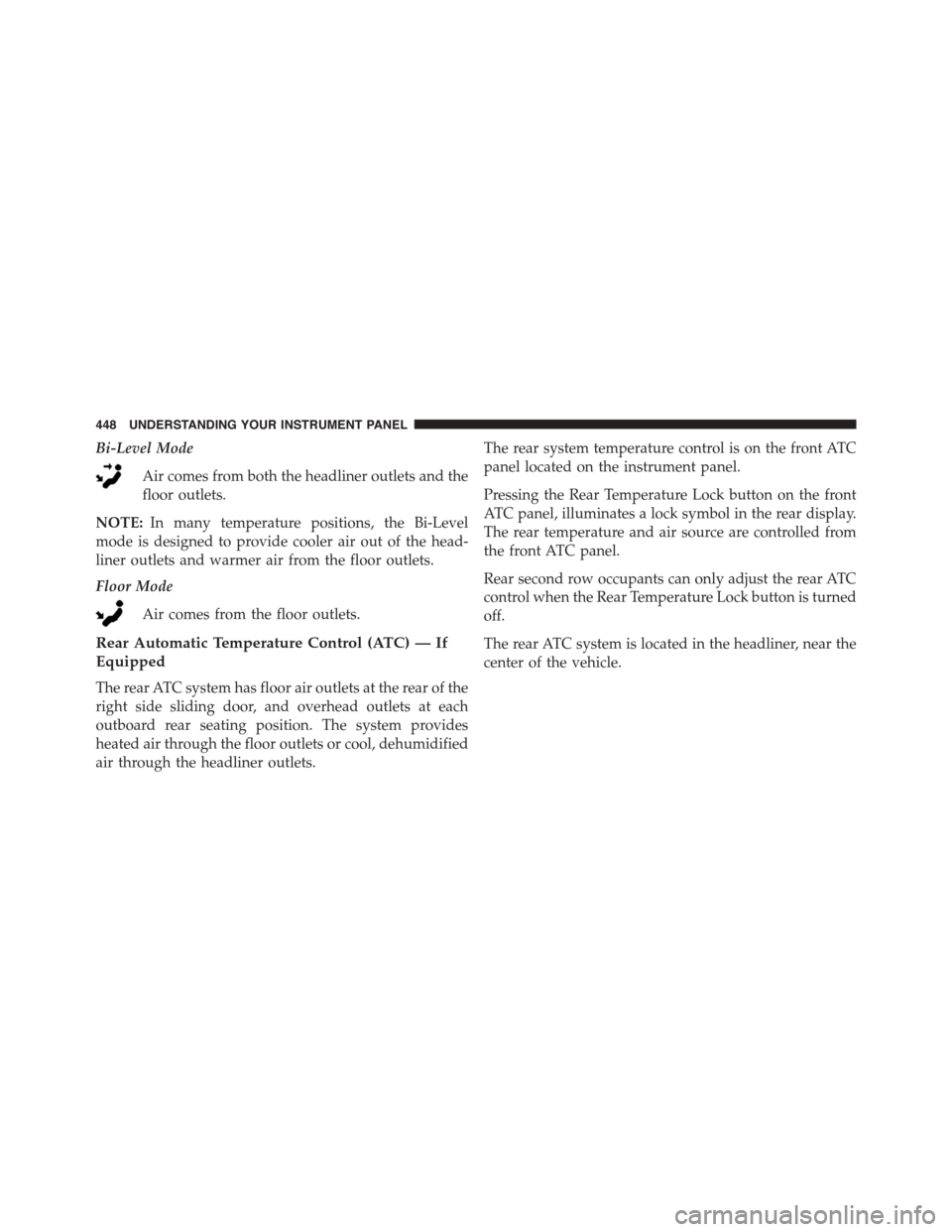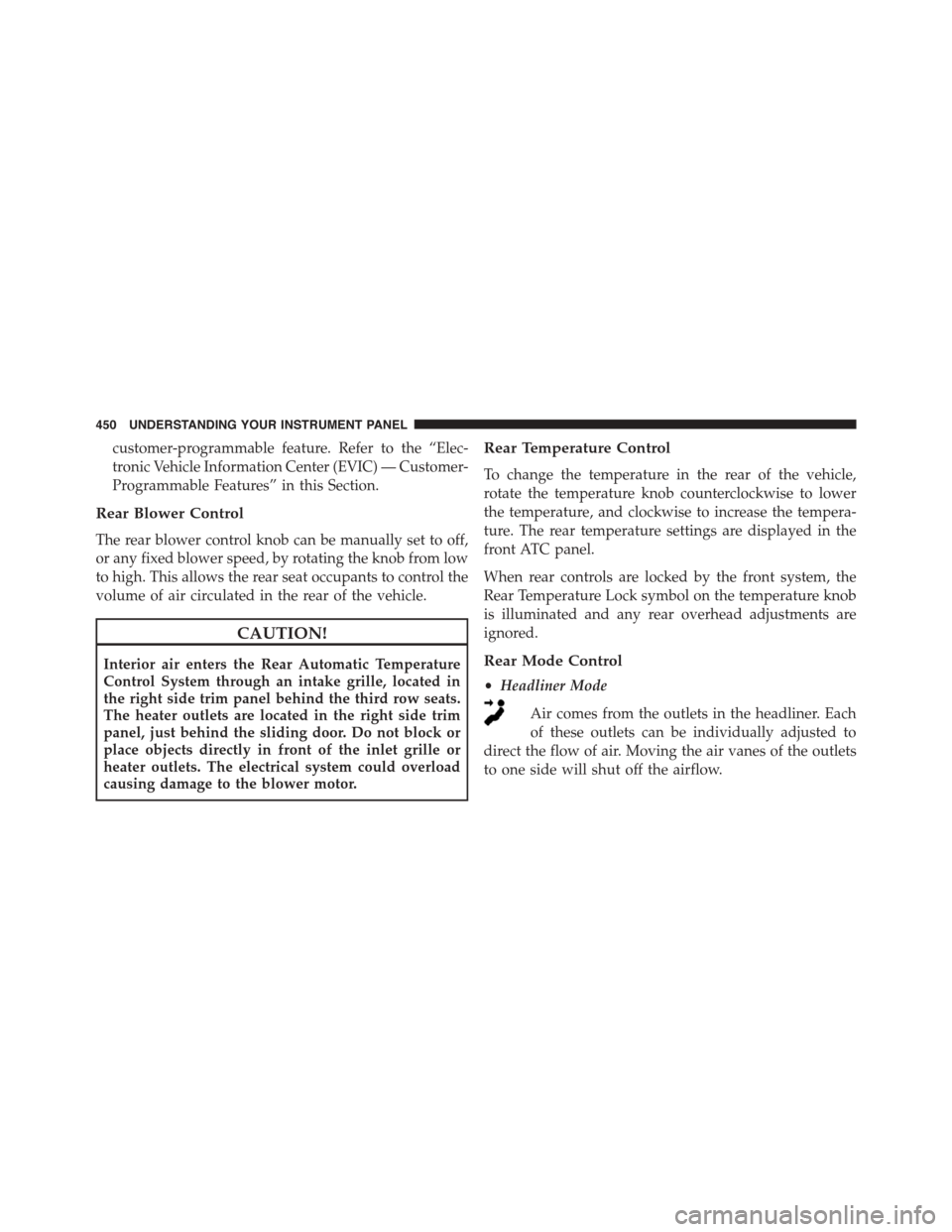Page 450 of 703

Bi-Level Mode
Air comes from both the headliner outlets and the
floor outlets.
NOTE:In many temperature positions, the Bi-Level
mode is designed to provide cooler air out of the head-
liner outlets and warmer air from the floor outlets.
Floor Mode
Air comes from the floor outlets.
Rear Automatic Temperature Control (ATC) — If
Equipped
The rear ATC system has floor air outlets at the rear of the
right side sliding door, and overhead outlets at each
outboard rear seating position. The system provides
heated air through the floor outlets or cool, dehumidified
air through the headliner outlets.
The rear system temperature control is on the front ATC
panel located on the instrument panel.
Pressing the Rear Temperature Lock button on the front
ATC panel, illuminates a lock symbol in the rear display.
The rear temperature and air source are controlled from
the front ATC panel.
Rear second row occupants can only adjust the rear ATC
control when the Rear Temperature Lock button is turned
off.
The rear ATC system is located in the headliner, near the
center of the vehicle.
448 UNDERSTANDING YOUR INSTRUMENT PANEL
Page 452 of 703

customer-programmable feature. Refer to the “Elec-
tronic Vehicle Information Center (EVIC) — Customer-
Programmable Features” in this Section.
Rear Blower Control
The rear blower control knob can be manually set to off,
or any fixed blower speed, by rotating the knob from low
to high. This allows the rear seat occupants to control the
volume of air circulated in the rear of the vehicle.
CAUTION!
Interior air enters the Rear Automatic Temperature
Control System through an intake grille, located in
the right side trim panel behind the third row seats.
The heater outlets are located in the right side trim
panel, just behind the sliding door. Do not block or
place objects directly in front of the inlet grille or
heater outlets. The electrical system could overload
causing damage to the blower motor.
Rear Temperature Control
To change the temperature in the rear of the vehicle,
rotate the temperature knob counterclockwise to lower
the temperature, and clockwise to increase the tempera-
ture. The rear temperature settings are displayed in the
front ATC panel.
When rear controls are locked by the front system, the
Rear Temperature Lock symbol on the temperature knob
is illuminated and any rear overhead adjustments are
ignored.
Rear Mode Control
•Headliner Mode
Air comes from the outlets in the headliner. Each
of these outlets can be individually adjusted to
direct the flow of air. Moving the air vanes of the outlets
to one side will shut off the airflow.
450 UNDERSTANDING YOUR INSTRUMENT PANEL
Page 624 of 703

cover, make sure the retaining tabs fully engage the
cover.
CAUTION!
The A/C air filter is identified with an arrow to
indicate airflow direction through the filter. Failure
to properly install the filter will result in the need to
replace it more often.
7. Rotate the glove compartment door back into position.
Body Lubrication
Locks and all body pivot points, including such items as
seat tracks, door hinge pivot points and rollers, liftgate,
tailgate, decklid, sliding doors and hood hinges, should
be lubricated periodically with a lithium based grease,
such as MOPAR® Spray White Lube to assure quiet, easy
operation and to protect against rust and wear. Prior to
the application of any lubricant, the parts concerned
should be wiped clean to remove dust and grit; after
lubricating excess oil and grease should be removed.
Particular attention should also be given to hood latching
components to ensure proper function. When performing
other underhood services, the hood latch, release mecha-
nism and safety catch should be cleaned and lubricated.
The external lock cylinders should be lubricated twice a
year, preferably in the Fall and Spring. Apply a small
amount of a high quality lubricant, such as MOPAR®
Lock Cylinder Lubricant directly into the lock cylinder.
Windshield Wiper Blades
Clean the rubber edges of the wiper blades and the
windshield periodically with a sponge or soft cloth and a
mild nonabrasive cleaner. This will remove accumula-
tions of salt or road film.
622 MAINTAINING YOUR VEHICLE
Page 646 of 703
Cavity Cartridge Fuse Mini-FuseDescription
J140 Amp Green–Power Folding Seat
J230 Amp Pink–Power Liftgate Module
J330 Amp Pink–Rear Door Module
J425 Amp Clear–Driver Door Node
J525 Amp Clear–Passenger Door Node
J640 Amp Green–Antilock Brakes Pump/Stability Control System
J730 Amp Pink–Antilock Brakes Valve/Stability Control System
J840 Amp Green–Power Memory Seat – If Equipped
J940 Amp Green–Partial Zero Emissions Vehicle Motor/Flex Fuel –
If Equipped
J1030 Amp Pink–Headlamp Wash/Manifold Tuning Valve – If
Equipped
J1130 Amp Pink–Power Sliding Door Module/Anti–Theft Module
– If Equipped
J1230 Amp Pink–HVAC Rear Blower, Radiator Fan Motor
644 MAINTAINING YOUR VEHICLE
Page 648 of 703
Cavity Cartridge Fuse Mini-FuseDescription
M6–20 Amp Yellow Power Outlet #1 (ACC), Rain Sensor, Cigar
Lighter (Instrument Panel or with Console Rear)
M7–20 Amp Yellow Power Outlet #2 (BATT/ACC SELECT) – Center
Seat or with Console Rear
M8–20 Amp YellowFront Heated Seat – If Equipped
M9–20 Amp YellowRear Heated Seat – If Equipped
M10–15 Amp Blue Ignition Off Draw — Video System, Satellite Ra-
dio, DVD, Hands-Free Module, Universal Garage
Door Opener, Vanity Lamp, Streaming Video
Module – If Equipped
M11–10 Amp RedClimate Control System
M12–30 Amp GreenAmplifier/Radio
M13–20 Amp Yellow Instrument Cluster, SIREN, Clock Module, Multi-
Function Control Switch – If Equipped
M14–20 Amp YellowTrailer Tow – If Equipped
646 MAINTAINING YOUR VEHICLE
Page 651 of 703
Cavity Cartridge Fuse Mini-FuseDescription
M37–10 Amp Red Antilock Brakes, Stability Control, Stop Lamp,
Fuel Pump
M38–25 Amp Clear Door Lock/Unlock Motors, Liftgate Lock/Unlock
Motors
The power windows are fused by a 25 Amp circuit
breaker located in the Totally Integrated Power Module.
VEHICLE STORAGE
If you are leaving your vehicle dormant for more than 21
days, you may want to take steps to protect your battery.
You may do the following:
•Remove the 60 Amp cartridge in the Totally Integrated
Power Module (TIPM) labeled Ignition-Off Draw
(IOD).
•Or, disconnect the negative cable from the battery.
•Anytime you store your vehicle, or keep it out of
service for two weeks or more, run the air conditioning
system at idle for about five minutes in the fresh air
and high blower setting. This will ensure adequate
system lubrication to minimize the possibility of com-
pressor damage when the system is started again.7
MAINTAINING YOUR VEHICLE 649
Page 655 of 703
Fog Lamps
NOTE:Access to the fog lamp bulb is from the rear of
the fascia. On the left rear side of the fascia, remove the
push pin and lower the hinged access door on the air
dam.
1. From behind the bumper fascia, or the access panel on
the air dam, squeeze the two tabs on the side of the
bulb socket and pull straight out from the fog lamp.
CAUTION!
Do not touch the new bulb with your fingers. Oil
contamination will severely shorten bulb life. If the
bulb comes in contact with an oily surface, clean the
bulb with rubbing alcohol.
2. Disconnect the wire harness from the bulb.
3. Reconnect the wiring harness to the new bulb and
reinstall by inserting the new bulb straight into the fog
lamp until it locks into place.
7
MAINTAINING YOUR VEHICLE 653
Page 683 of 703

Anti-Lock Warning Light....................314
Appearance Care.........................635
Ashtray................................278
Assistance Towing.........................162
Assist, Hill Start..........................492
Auto Down Power Windows..................41
Automatic Dimming Mirror..................134
Automatic Door Locks......................38
Automatic Headlights......................223
Automatic Temperature Control (ATC)..........440
Automatic Transmission....................462
Adding Fluid..........................634
Fluid and Filter Changes..................634
Fluid Change..........................634
Fluid Level Check.......................634
Fluid Type............................633
Gear Ranges...........................467
Special Additives.......................633
Torque Converter.......................474
Auto Up Power Windows....................42
Battery.................................618
Jump Starting..........................594
Keyless Transmitter Replacement (RKE)........28
Saving Feature (Protection)................229
Belts, Seat...............................122
Body Mechanism Lubrication.................622
B-Pillar Location..........................502
Brake Assist System.......................487
Brake Control System, Electronic..............483
Brake Fluid.............................659
Brake System............................482
Anti-Lock (ABS)........................482
Fluid Check...........................631
Parking..............................480
Warning Light.........................320
Brake/Transmission Interlock.................464
BulbReplacement.........................65210
INDEX 681